Blast from Black Hole in a Galaxy Far, Far Away

The Star Wars franchise has featured the fictitious "Death Star," which can shoot powerful beams of radiation across space. The Universe, however, produces phenomena that often surpass what science fiction can conjure.
The Pictor A galaxy is one such impressive object. This galaxy, located nearly 500 million light years from Earth, contains a supermassive black hole at its center. A huge amount of gravitational energy is released as material swirls towards the event horizon, the point of no return for infalling material. This energy produces an enormous beam, or jet, of particles traveling at nearly the speed of light into intergalactic space.
To obtain images of this jet, scientists used NASA's Chandra X-ray Observatory at various times over 15 years. Chandra's X-ray data (blue) have been combined with radio data from the Australia Telescope Compact Array (red) in this new composite image.
By studying the details of the structure seen in both X-rays and radio waves, scientists seek to gain a deeper understanding of these huge collimated blasts.
The jet [to the right] in Pictor A is the one that is closest to us. It displays continuous X-ray emission over a distance of 300,000 light years. By comparison, the entire Milky Way is about 100,000 light years in diameter. Because of its relative proximity and Chandra's ability to make detailed X-ray images, scientists can look at detailed features in the jet and test ideas of how the X-ray emission is produced.
In addition to the prominent jet seen pointing to the right in the image, researchers report evidence for another jet pointing in the opposite direction, known as a "counterjet". While tentative evidence for this counterjet had been previously reported, these new Chandra data confirm its existence. The relative faintness of the counterjet compared to the jet is likely due to the motion of the counterjet away from the line of sight to the Earth.
More information at http://chandra.si.edu/photo/2016/pictora/index.html
-Megan Watzke, CXC
Category:
- Log in to post comments
